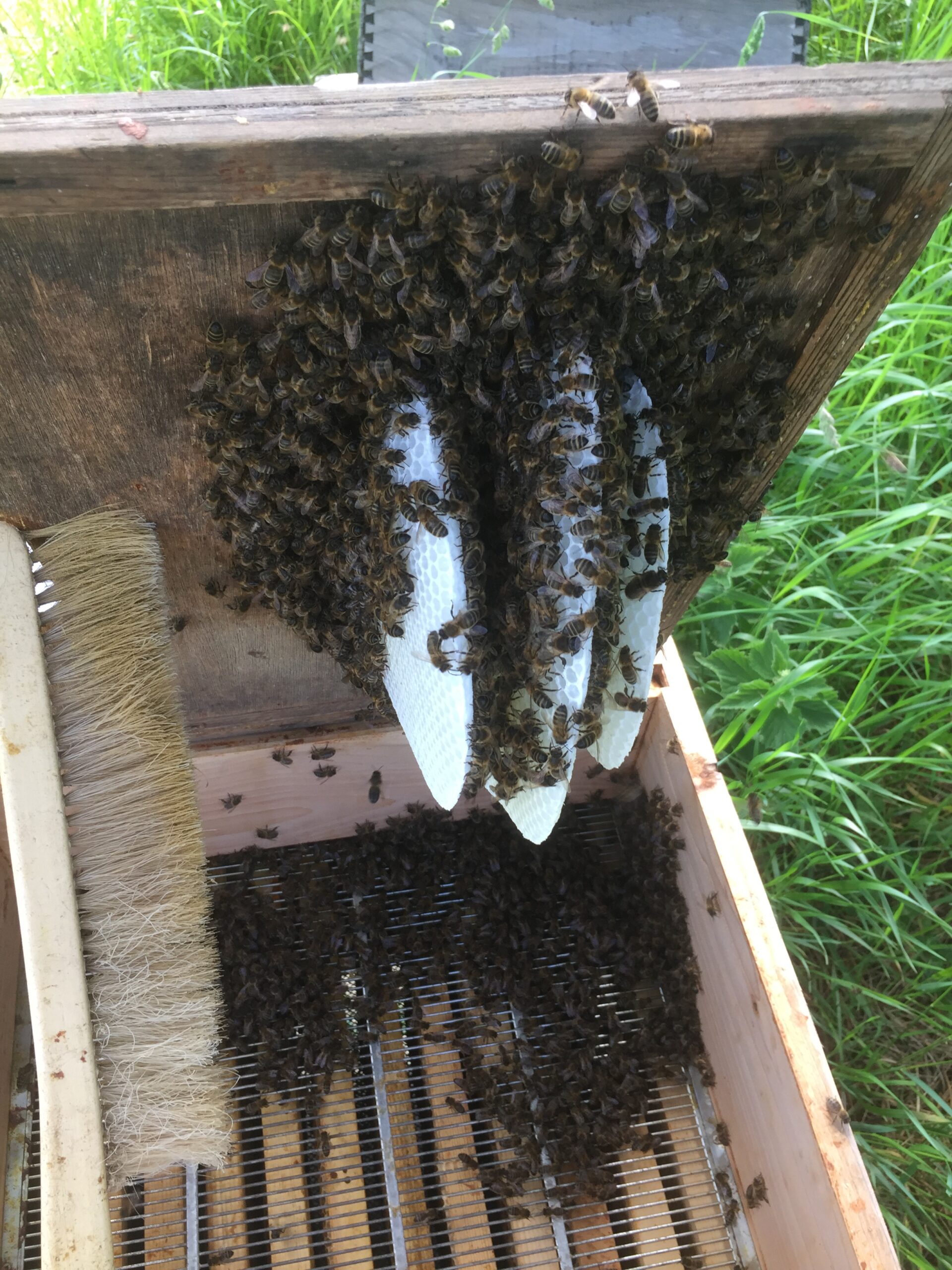So, another busy month for swarms. Not surprising, I suppose, when one remembers the swarming season is essentially May through July, though it can start earlier and finish a lot later in some years.
It started with a telephone call about a swarm hanging from the branch of a tree reaching out over the Ruan River!
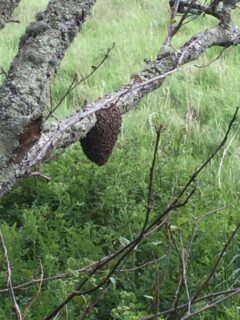
Luckily, the tide was out so I was able to reach it without needing waders or a boat to get to it! Two days later came the next into the bait hive on my friend’s shed roof. Now, I obviously don’t need to increase the number of my colonies beyond a certain point (so Lin tells me!), so I had already decided, as part of my season’s planning, that any excess swarms would be used to populate my jumbo Langstroth poly hive, uniting multiple swarms as appropriate, as I had never quite managed to keep a sufficiently populous colony in that very large hive. So the swarm over the river was put in the Langstroth poly brood box
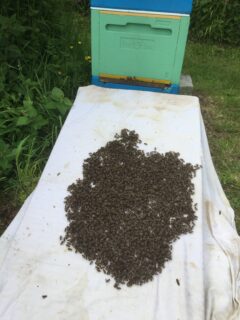
and the bait hive swarm I decided to use to draw comb in the Langstroth’s super (which the bees had never touched, always finding the brood box itself either sufficient or too large to bother about using the super). But if I hived a swarm in the super and it had a laying queen, then that would mean the super would get filled with brood – and I didn’t want that. So I devised a cunning plan (to quote Baldrick)! I set up the super on a floor alongside the Langstroth brood box, put a queen excluder on top, followed by another empty super on top of the queen excluder.
I then poured the bait hive swarm into the empty super, the bees mainly went through the excluder to the starter strips below, leaving the queen to be easily found.
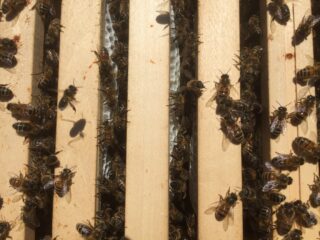 I placed her in a queen cage and suspended that between two of the frames in the lower super. This meant that the colony had a queen but she would not be able to lay in any comb they built. Sure enough, they drew out the comb in a matter of days at which point I removed the queen and some of the bees into a nucleus hive and left the remaining bees to settle down.
I placed her in a queen cage and suspended that between two of the frames in the lower super. This meant that the colony had a queen but she would not be able to lay in any comb they built. Sure enough, they drew out the comb in a matter of days at which point I removed the queen and some of the bees into a nucleus hive and left the remaining bees to settle down.
I then covered the brood box with a sheet of paper, placed a queen excluder on top of that to hold it in place, and that evening I gently lifted the super and bees onto the queen excluder on the brood box. Over the next couple of days the bees upstairs, wanting to get out, chewed their way through the paper and united slowly and peacefully with the bees in the brood box. I then had a colony of bees in the Langstroth with drawn comb in the super and starter strips in the brood box, which the river swarm had already started to draw out into comb. Job done!
A week later, I had a swarm (one of mine!) occupy the plant pot bait hive in our courtyard, the first time a swarm has occupied one of these, so well pleased!
I then had another call to the shed roof bait hive that same day. The weather at this point was very mizzly, so whilst the plant pot bees were hived in a nuc box in the apiary in far from desirable conditions,I left the shed bait hive on a stand in my apiary until the weather improved. By then they had drawn three lovely combs of wax on the crown board,
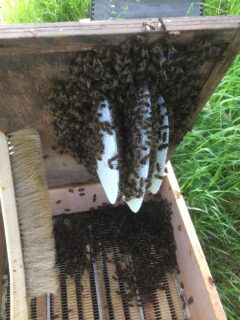
which I cut off and tied in to empty frames in a National brood box. I also tried the filtering technique again – but no queen was found on the excluder! This meant the swarm was either queen-less (highly unlikely) or it was a cast, a secondary swarm, with an unmated and therefore smaller queen who could squeeze through the excluder. This subsequently proved to be the case – or did it? However, though I had hived the swarm into the brood box, when I checked that evening the bees were clustered under the floor to the side of the hive!
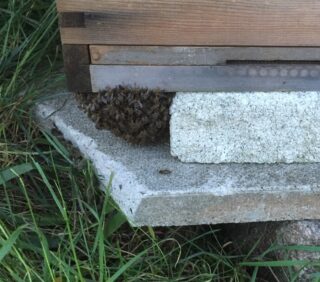
I brushed them off into an ice cream box and gently dropped them back into the hive – but they came out again and were clustered in the same place the following morning. The hive had an open mesh floor and I wondered if that was something to do with the problem. Perhaps the queen was inside the brood box and the bees were smelling her pheromones through the mesh underneath. I therefore made a new, solid floor for the hive, moved the hive to one side, placed the new floor on the original site, put the brood box on the new floor and brushed the bees off the open mesh floor back into the brood box. This appeared to do the trick, but there were no flying bees out and about as I would have expected to see – the bees were just trying to cluster together and were not moving very much at all.
Suddenly it dawned – a starvation swarm! This is where a colony absconds in total from a hive because of shortage of forage in the hope that another location will be more favourable for them. I immediately sprayed them with 1:1 sugar syrup and placed a feeder on the crown board. Within minutes they came back to life and started behaving as I would have expected. So maybe the queen was a mated queen after all, just slimmed down through lack of food thereby allowing her to squeeze through the excluder when I was filtering them. Who knows? The colony is doing fine now, so mated or virgin I don’t really mind, nor do I need to know as long as they are thriving, which they are.
Last month I told you about and empty hive that had been occupied by a swarm. Strangely, that no longer had bees in it – the queen must have been lost on her mating flight I guess, or the bees decided they wanted somewhere different. But then, I see signs of activity around the entrance again, indicating that another swarm was imminent.
I had a good idea which colony that would be and did an artificial swarm on it so it would think it had swarmed but it actually hadn’t. This is done by taking the queen and a frame of brood with some empty frames and placing them in a new box on the site of the original colony. The parent colony can then be re-sited anywhere in the apiary, the flying bees will return to the original site where the queen is now located, whilst the artificial swarm will continue to develop queen cells to produce a new queen and no swarming takes place as all the flying bees needed for a swarm have returned to the hive with the queen in.
As if I didn’t have enough to do with my own bees and bait hive swarms, I then had a call to remove bees from the roof of an outside boiler room in a stone built property. Luckily, the building was a fairly recent build and was well constructed – the fascia board fitted almost flush with the stonework with only one section with a gap whilst the slates were all sitting flat with no gaps. Easy, I thought! How wrong can one be, after so many years?! I blocked the gaps with foam rubber and placed a pipe, with a cone one-way valve on the end of it, through the gap behind the fascia. I set a queen-right nucleus on top of a ladder, next to the cone and pipe and left them to it.
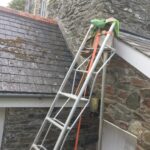
Returning next day, I found the bees had forced their way through the foam and were flying almost as normal, so I closed up the gap with gaffer tape and hoped that would be it.. But it wasn’t! I have been back almost every day to find that the bees had found another “back door” to their original nest – and queen! This is par for the course with roof colonies. They are persistent if nothing else – but so am I! I’ll get them in the end!. I might need another roll of gaffer tape, mind you!!
Whilst all this was going on, I checked on the jumbo Langstroth to make sure everything was going to plan – it wasn’t! The queen had obviously failed to return from her mating flight, so the hive was queen-less and had developed laying workers. This is the situation where, in the absence of brood or queen pheromones, some workers’ ovaries kick in and start to produce eggs. But of course the workers cannot mate as they do not have the physiological capability to do so. This means they can only lay unfertilised eggs, thus producing drones. Whilst drones are necessary in a colony, they do not do any work – no foraging, no house-work – nothing! A colony will therefore die unless remedial action is taken. In my case (very timely!) another swarm took up residence in the shed roof bait hive, just at the right time. I therefore set up the retrieved bait hive alongside the jumbo Langstroth in readiness to unite the two colonies. But first I had to get rid of the laying workers, otherwise they would kill the “intruder” queen..
As it is not possible to identify laying workers, the only thing to do is to take the hive to the bottom of the field, brush out all the bees and return the hive to its site. The laying workers are unable to fly back home (basically because they are effectively pregnant) but the non-laying workers can and by placing the bait hive on the original site they united peacefully with the swarm bees. All I had to do then was to switch the two hives again, putting the Langstroth back on its original site, and brush all the bees in the bait hive into the Langstroth. I think it’s taken longer to describe the process than it took to actually do it but it is now done – I hope you kept up!
Having taken the bait hive (now empty) back to the house to check the combs, I found that the bees had drawn a lot of comb whilst in there (the weather had been wet and prevented me from moving them out as soon as I would normally). Not only that but the queen had laid up almost all of it with eggs (so she was a mated queen and it was a prime swarm). Rather than waste this amount of brood, I then proceeded to cut out the laid-in comb and tie it in to two empty Langstroth frames which I then added to the Langstroth hive. That will give the bees a good start to establishing their new nest. A full super frame of eggs from the bait hive didn’t fit the Langstroth, so, rather than cutting it out, I gave the whole frame of eggs to one of my other swarms to give that a kick start too. What a kerfuffle!
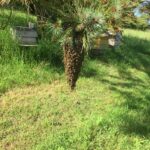 This month has been particularly busy with swarms and I’m beginning to understand why Lin says I spend all the summer months on my bees! It’s beginning to feel a little like that at the moment!!
This month has been particularly busy with swarms and I’m beginning to understand why Lin says I spend all the summer months on my bees! It’s beginning to feel a little like that at the moment!!
And it’s not finished yet! My most recent swarm was a classic “bunch of grapes” hanging off a low tree branch in the apiary.
It must have only arrived minutes before I found it as the bees were still lying round and round, not settled in a tight cluster as is usually the case. I collected the swarm in my Swarm Box
and hived it the following day in an empty hive in the apiary on jumbo starter strips, since when it’s been going great guns.
I’ m going to stop here, though there’s a lot more to tell you, but this has been a long report (it’s been a long month!) and, as you can see, being a beekeeper can become an obsession and can take up a lot of time if you choose to do it the way I do – but my word, is it satisfying to know that these vitally important insects are being saved for our planet. They are responsible for every third mouthful of food that we eat and, as Einstein is quoted as saying, “If the honey bee dies out, mankind will follow within four years”. I don’t want to find out the hard way that he was right!
Colin Rees 01872 501313 07939 971104 colinbeeman@aol.com
, another busy month for swarms. I suppose, when one remembers the swarming season is essentially May through July

